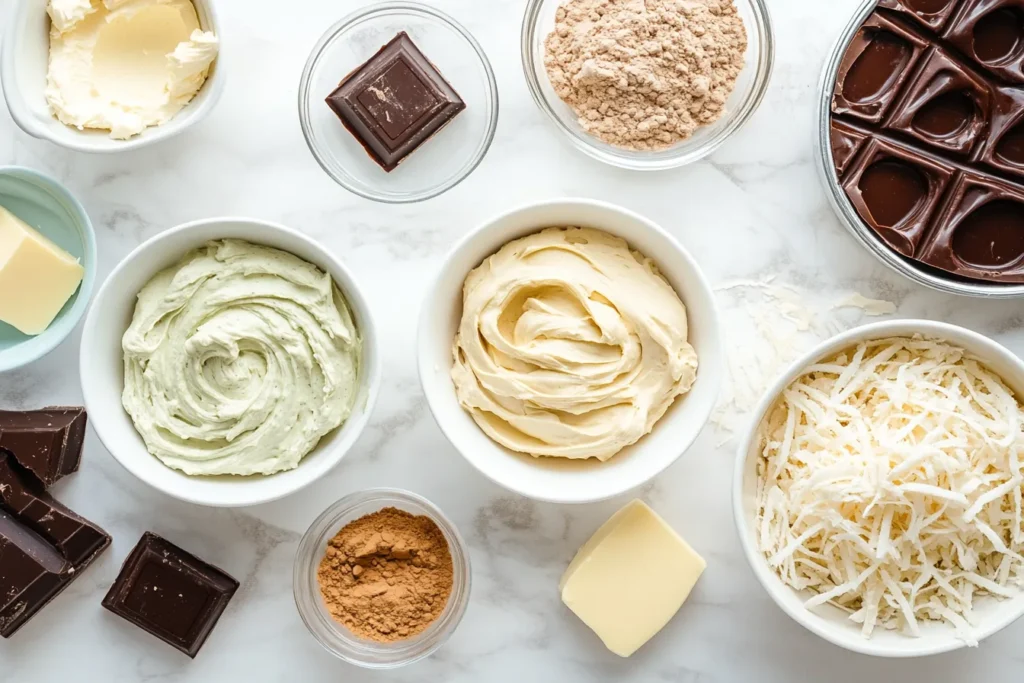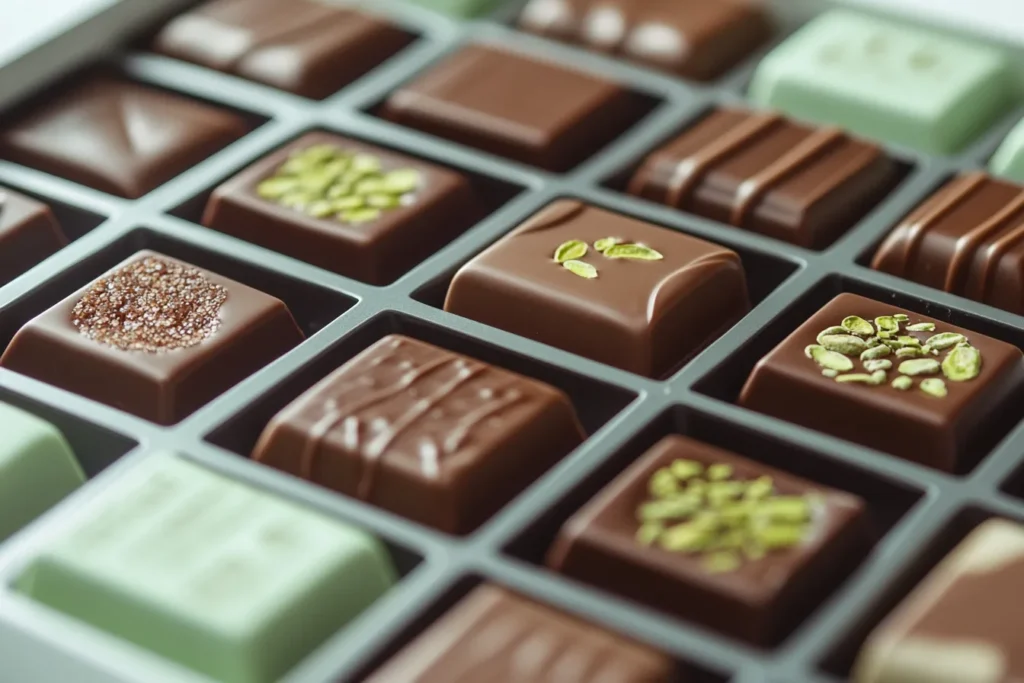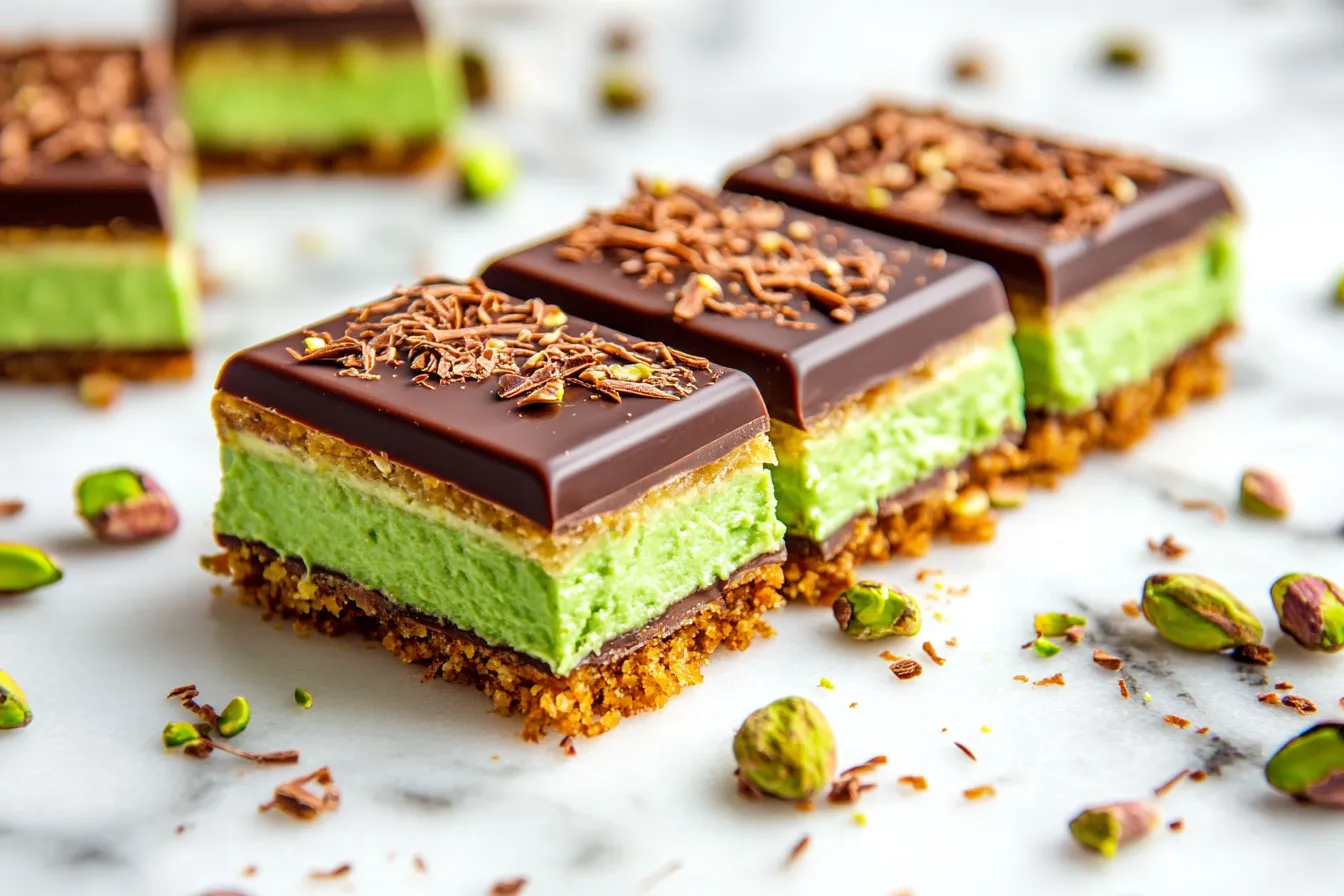Introduction
Few desserts have captured the internet’s attention quite like Dubai chocolate. A rich, indulgent, and visually stunning treat, this pistachio-filled chocolate bar has exploded on platforms like TikTok and Instagram, quickly becoming one of the most sought-after sweets in the world. But what exactly is Dubai chocolate, and why has it caused such a frenzy?
This viral confection originated in the UAE and is most famously associated with Fix Dessert Chocolatier, a boutique pastry brand in Dubai. Their signature creation—featuring a creamy pistachio and tahini center wrapped in crispy kataifi pastry and coated in rich chocolate—has become a global sensation. Foodies are raving about its complex flavors and irresistible textures, while home bakers and chefs are scrambling to recreate it in their own kitchens..Boston Kreme Dunkin Donut Guide You’ll Love
In this article, we’ll break down everything you need to know about Dubai chocolate: from its origins and viral success to how you can make it at home. We’ll dive into the core ingredients, explore why it’s so addictive, and provide insight into the cultural inspiration behind the trend. Whether you’re curious about its popularity or looking to try it yourself, this guide will give you the full scoop.
Stay with us as we explore the delicious journey of the Dubai chocolate phenomenon—step by decadent step.
What Is Dubai Chocolate?
A Viral Sensation from the UAE
Dubai chocolate is not your average candy bar. It’s a luxurious, handcrafted dessert that combines Middle Eastern flavors with European chocolate craftsmanship. At its core, it’s a chocolate bar filled with toasted kataifi pastry, creamy pistachio spread, tahini, and a pinch of sea salt, all enrobed in rich chocolate. The flavor is nutty, sweet, and subtly savory, while the texture offers a delightful crunch wrapped in silkiness.
The Origins of Dubai Chocolate
The original Dubai chocolate bar is credited to Fix Dessert Chocolatier, a high-end dessert boutique based in Dubai and Abu Dhabi. Launched in 2021, the bar was crafted to fuse local traditions with global appeal. The inspiration comes from the famous Levantine dessert knafeh, known for its crunchy pastry and creamy cheese or nut filling. By replacing the cheese with pistachio spread and dipping it in chocolate, Fix created something both nostalgic and innovative.
The dessert initially gained traction among local dessert lovers but quickly exploded in popularity thanks to its stunning visuals, rich flavors, and clever marketing. Today, it’s widely known as one of the most viral dessert trends to come out of the Middle East..Brownie Oil Substitute Banana You’ll Love
Core Characteristics
What sets Dubai chocolate apart from regular chocolate bars is its unique blend of ingredients and textures:
- Crispy toasted kataifi: Thin shredded pastry that adds crunch and authenticity.
- Pistachio cream: A vibrant green filling that’s rich, nutty, and slightly sweet.
- Tahini: Adds depth with a sesame note, complementing the pistachio.
- High-quality chocolate shell: Either dark, milk, or white chocolate, usually with a glossy finish.
- Optional sea salt or edible gold: To elevate the presentation and flavor contrast.
This combination creates a multi-layered bite that is unlike anything commonly found in Western desserts. It’s indulgent yet balanced, making it appealing to a broad range of palates.
The Story Behind the Trend
Fix Dessert Chocolatier’s Breakout Product
When Fix Dessert Chocolatier launched the Dubai chocolate bar, their intention was to reimagine Middle Eastern flavors through the lens of luxury desserts. The concept resonated almost instantly. Food bloggers and influencers began showcasing the product in unboxing videos and taste tests, highlighting not only its flavor but also its photogenic appearance.
The dessert’s bright green interior—thanks to the pistachio—and golden crisp kataifi exterior drew comparisons to precious gems and modern art. This visual element made it perfect for social media, especially in short-form videos and aesthetic flat lays.
Social Media Fuel
In late 2023, the Dubai chocolate trend hit TikTok and Instagram Reels hard. Short, satisfying videos of the bar being cut open to reveal the vibrant green filling quickly garnered millions of views. Food influencers like @siftwithkima and @feelgoodfoodie shared tutorials and recreations, further amplifying the buzz.
Some key reasons it went viral include:
- Visual aesthetics: The color contrast between the green pistachio, golden pastry, and dark chocolate is striking.
- ASMR appeal: Crunchy sounds from slicing or biting into the bar make it addictive to watch.
- Exclusivity: Initially, it was only available in the UAE, giving it a “rare dessert” allure.
- Homemade versions: The DIY crowd quickly jumped in, recreating it with accessible ingredients, making it more widespread.
Global Reach
By early 2024, Dubai chocolate became a trending dessert not just in the Middle East but also in North America, Europe, and Southeast Asia. People began searching for where to buy it, how to make it, and why it was so unique. Major brands like Lindt, Läderach, and even Trader Joe’s started experimenting with pistachio-based chocolate products to ride the wave.
Even mainstream media picked up on the trend. The dessert was featured in publications like Food & Wine, The Kitchn, AllRecipes, and Taste of Home, cementing its status as the dessert of the year.
Core Ingredients Breakdown
Kataifi Pastry – The Crunchy Base
One of the most defining ingredients in Dubai chocolate is kataifi pastry, sometimes referred to as shredded phyllo dough. Commonly used in Middle Eastern and Mediterranean desserts like knafeh or kataifi nests, this pastry is made from long, thread-like strands of dough that become deliciously crisp when toasted in butter or oil.
For Dubai chocolate, kataifi is typically toasted in ghee or unsalted butter until golden brown. The crunch it provides is unmatched, giving each bite a satisfying texture that contrasts beautifully with the creamy filling.
You can find kataifi in the frozen section of most Middle Eastern or specialty grocery stores. It’s important to separate the strands before toasting so they don’t clump together.
Pistachio Cream – The Star of the Show
The vibrant green filling inside the Dubai chocolate bar is made from pistachio cream. This ingredient offers:
- Rich nuttiness
- A natural sweet aroma
- Eye-catching color
Pistachio cream is made by grinding roasted pistachios into a paste and blending it with ingredients like milk powder, sugar, and a touch of oil for smoothness. Some versions include white chocolate or sweetened condensed milk to achieve a luxurious consistency.
If you’re making it at home, you can use store-bought pistachio spread or make your own by blending:
- 1 cup of roasted pistachios
- 1 tbsp of neutral oil (e.g., sunflower)
- 2 tbsp powdered sugar
- Pinch of salt
Add milk powder or sweetened condensed milk for a richer flavor.
Tahini – The Secret Layer of Depth
Tahini, a paste made from ground sesame seeds, is sometimes added to the pistachio filling for an extra layer of complexity and nuttiness. While optional, it adds richness and creates a beautiful contrast with the chocolate shell.
The nutty, slightly bitter notes of tahini balance the sweetness of the pistachio and chocolate, making the dessert feel more grown-up and gourmet.
High-Quality Chocolate – The Outer Shell
To complete the Dubai chocolate bar, the filling is encased in melted chocolate, which hardens into a glossy shell. Popular choices include:
- Dark chocolate: For a rich, less-sweet contrast
- Milk chocolate: For a smoother, traditional taste
- White chocolate: For visual contrast and added creaminess
The chocolate is often tempered to ensure it sets with a crisp snap and a glossy finish. Some recipes add a bit of coconut oil to help with the melting process and give a smoother texture.
Optional Garnishes
While not mandatory, the final touch often includes:
- A sprinkle of sea salt for contrast
- Edible gold flakes or crushed pistachios for luxury
- A drizzle of white chocolate or pistachio paste on top

Dubai Chocolate Recipe (DIY at Home)
Ingredients You’ll Need
To make 4 medium Dubai chocolate bars at home, you’ll need:
- 1 cup kataifi pastry (shredded phyllo dough)
- 2 tbsp unsalted butter or ghee
- ½ cup pistachio cream (store-bought or homemade)
- 1 tbsp tahini (optional)
- 200g high-quality chocolate (dark, milk, or white)
- 1 tsp coconut oil (optional, for smoother chocolate)
- Pinch of sea salt
- Silicone bar molds (or muffin cups as an alternative)
Instructions Step-by-Step
Step 1: Toast the Kataifi
- Defrost kataifi pastry if frozen.
- In a large non-stick skillet, melt the butter on medium heat.
- Add kataifi, breaking up the strands with your fingers.
- Stir continuously until golden and crispy (around 7–10 minutes).
- Set aside to cool.
Step 2: Prepare the Filling
- In a bowl, mix pistachio cream and tahini until smooth.
- Add the cooled kataifi and stir to combine.
- Sprinkle a pinch of sea salt for flavor enhancement.
Step 3: Melt the Chocolate
- Use a double boiler or microwave in 30-second intervals to melt the chocolate.
- Stir in coconut oil if using, for a smoother, shinier texture.
Step 4: Mold the Bars
- Spoon melted chocolate into silicone molds, coating the bottom and sides.
- Refrigerate for 10–15 minutes until set.
Step 5: Add the Filling
- Spoon the pistachio-kataifi mixture into the mold, pressing gently to fill.
- Cover with more melted chocolate to seal the bar.
Step 6: Chill and Set
- Refrigerate for 1–2 hours, or until fully hardened.
- Remove from molds and let sit at room temperature for 5–10 minutes before serving.
Storage Tips
- Store in an airtight container at room temperature (up to 3 days) or in the fridge (up to 1 week).
- You can also freeze the bars for up to a month. Let them thaw for 10 minutes before serving.
Optional Variations
- Add a layer of Nutella or white chocolate chips in the filling.
- Top with pistachio dust, rose petals, or edible glitter.
- Make mini bars or bite-sized cups using smaller molds.
This recipe makes it easy to bring the magic of Dubai chocolate to your home kitchen—whether you’re prepping for a dinner party or satisfying your own sweet tooth.

Viral Variations & Dessert Spinoffs
TikTok Takes It Further
Once Dubai chocolate took off on social media, creators didn’t just stop at copying the original. Instead, they launched a wave of creative variations—some simple, some gourmet, and others downright unexpected. These spinoffs have kept the trend fresh and helped it reach a wider audience. Here’s how the internet reimagined Dubai chocolate:
Mini Cups and Bites
Small, bite-sized Dubai chocolate cups have become a favorite for parties and gift boxes. They’re made using silicone mini molds or even cupcake liners, with the same pistachio-kataifi filling inside. These are easy to portion, less messy, and perfect for snacking.
Many food influencers have adopted this format because it’s quick to prepare and perfect for content styling. Sift With Kima’s Instagram-famous pistachio bombs are a perfect example.
Trifles and Layered Jars
Another hit variation is the Dubai chocolate trifle, layered in small jars or glasses. These typically include:
- A base of crumbled pistachio cake or biscuit
- A middle layer of pistachio-tahini filling
- A chocolate ganache topping
- Garnishes like pistachio crumbs, rose petals, or gold leaf
These jar desserts are highly visual and work well in bakeries and catering menus. SF Chronicle even featured a Dubai Chocolate Strawberry Trifle, which added a tart contrast with fresh berries—perfect for summer events.
Croissant and Pastry Fillings
Some bakeries have begun using the Dubai chocolate filling in croissants, donuts, and éclairs, taking the core idea and inserting it into classic pastries. Toasted kataifi bits are often sprinkled on top for texture. The result? A fusion pastry that feels both traditional and trendy.
Even large chains are exploring the idea. Trader Joe’s has hinted at pistachio pastry snacks, and Dunkin’ has already tested pistachio-filled chocolate donuts in selected locations.
Vegan & Allergy-Friendly Versions
To appeal to more consumers, health-conscious influencers are creating vegan and gluten-free Dubai chocolate alternatives:
- Vegan chocolate (dairy-free) and nut-free options using sunflower seed butter
- Using maple syrup or agave as natural sweeteners
- Coconut oil instead of butter for toasting the kataifi
These lighter spins still retain the texture and richness that make Dubai chocolate so desirable.

Where to Buy Dubai Chocolate
The Original: Fix Dessert Chocolatier
If you’re looking for the real-deal Dubai chocolate, your first stop should be Fix Dessert Chocolatier, located in Dubai and Abu Dhabi. They are credited with creating the trend and still offer the highest-quality version of this luxurious dessert.
Their signature bars are handmade, available in premium boxes, and sometimes include flavors like rose pistachio, halva, or even saffron-infused chocolate. They also offer international delivery to select countries. You can order through their official Instagram or through curated dessert boxes like Sugargram UAE.
Pop-up Stands and UAE Boutiques
Due to the popularity, several UAE-based patisseries now sell their own interpretations of the Dubai chocolate bar. Shops like:
- Home Bakery
- Sugaholic
- The Hummingbird Bakery (Dubai)
These offer everything from traditional bars to playful flavors like pistachio & raspberry or dark chocolate & orange.
Global Availability
The dessert’s fame has pushed it beyond Dubai and into international markets. Here’s where else you can find it:
Supermarket Chains
- Lidl Ireland: Introduced a Dubai Chocolate Muffin in June 2024. The muffin mimics the core concept—chocolate base, pistachio center, green frosting drizzle—for only €1.79. It sold out in many locations within days.
- Costco & Trader Joe’s: In the U.S., these chains are testing pistachio-based desserts inspired by Dubai chocolate.
- Waitrose UK: Has introduced pistachio chocolate bars with Middle Eastern flair, hinting at Dubai chocolate’s influence.
Online Artisanal Stores
Several gourmet chocolate shops now ship Dubai chocolate worldwide:
- Gold Leaf Gourmet (Canada)
- Maison Al-Hassan (France)
- Pistachio Bliss (U.S.-based startup, recently featured on TikTok)
Many of these versions are handmade and come in gift-ready boxes, making them ideal for holidays and special occasions.
Watch Out for Knock-Offs
Due to demand, many lower-quality imitations have entered the market. These may use artificial pistachio flavoring or skip the kataifi altogether. Look for:
- Ingredient transparency
- Proper layering (crunch, cream, chocolate)
- Clear photos and reviews
To ensure authenticity, choose trusted retailers or follow DIY recipes that mimic the original.
Why Is It So Addictive?
The Perfect Flavor Profile
What makes Dubai chocolate so hard to resist? It’s the strategic pairing of contrasting flavors that creates what chefs call a “complete sensory experience.”
- Nutty & Sweet: Pistachio cream delivers a deep, rich nuttiness, balanced with sweetness.
- Savory Edge: Tahini and sea salt provide an umami lift, deepening the flavor and keeping it from being overly sweet.
- Buttery Crunch: Kataifi pastry adds a subtle toasted, buttery layer.
- Chocolate Shell: Whether milk or dark, the chocolate ties everything together with richness and aroma.
This complexity hits all the right notes: salty, sweet, crunchy, and creamy—making every bite memorable. It appeals not just to those with a sweet tooth, but to people who crave something more layered and refined.
A Feast for the Senses
Dubai chocolate isn’t just about taste. It also targets visual appeal, mouthfeel, and even sound (the crunch!). That’s what makes it so successful in the social media age.
- Texture contrast: Smooth filling vs. crunchy pastry
- Color pop: Vibrant green pistachio against brown or white chocolate
- Aromatic notes: Pistachio, chocolate, sesame, and butter form an unforgettable scent
This dessert stimulates the senses in a way few other confections do—similar to the pleasure of eating a French mille-feuille or an Italian cannoli, but even more luxurious.
Psychological Indulgence
There’s a deeper reason behind its addictive nature: emotional comfort. Dubai chocolate offers a nostalgic reminder of traditional Middle Eastern sweets like baklava, halva, and knafeh, but in a modern, Instagrammable format.
This blend of old and new, tradition and trend, creates an emotional response. It’s comfort food—but elevated. Add the exclusivity factor (at least early in its release), and it becomes something consumers feel proud to discover and share.
The Influence of Middle Eastern Flavors
Rooted in Tradition
Dubai chocolate may feel like a viral innovation, but it’s firmly grounded in classic Middle Eastern desserts. The flavor combinations pull directly from:
- Knafeh: Known for its crispy kataifi crust and rich filling.
- Halva: A sweet tahini-based confection, dense and nutty.
- Baklava: Flaky pastry layered with nuts and soaked in syrup.
The smart adaptation was taking those flavors and refining them into a globally appealing shape—a neat, chocolate-covered bar. This brings Levantine flavors to a broader audience, without diluting their cultural significance.
Pistachios – A Regional Hero
Pistachios are a premium nut in Middle Eastern cuisine, often reserved for special occasions. Their use in Dubai chocolate:
- Signals luxury
- Provides intense flavor
- Ties the dessert to its regional roots
Whether in Turkish delight, Iranian nougat, or Lebanese pastries, pistachios have always been a sign of indulgence. Now, they’re front and center in a trend the whole world can taste.
Cultural Storytelling Through Dessert
Dubai chocolate isn’t just a treat; it’s culinary storytelling. It tells the story of:
- The modern Middle East’s fusion with Western trends
- A generation reconnecting with tradition through food
- How diaspora chefs use flavor to bridge identity and innovation
It’s this depth that separates it from flash-in-the-pan trends. It means something—and that meaning resonates across continents.

Social Media’s Role in Its Success
The TikTok Effect
Social media was the fuel to Dubai chocolate’s fire. A few viral TikTok videos in late 2023 showed users cutting open the bars to reveal the green center, and the trend exploded from there.
- #DubaiChocolate racked up millions of views
- ASMR slicing videos trended globally
- Home bakers began posting their own remakes
Influencers like @feelgoodfoodie, @siftwithkima, and @eatingthroughdubai introduced it to their large audiences, often pairing videos with close-up textures, dramatic lighting, and relaxing audio.
This helped the dessert reach beyond its regional origins and appeal to a global Gen Z and Millennial audience.
Instagram-Worthy Aesthetics
Instagram provided the next wave of virality, with curated feeds and food bloggers sharing:
- Colorful cross-sections of the bars
- High-end packaging unboxings
- Pistachio-themed dessert spreads
The visual impact—green interiors, shiny chocolate shells, crushed pistachio garnishes—made it instantly shareable.
Dubai chocolate became more than a dessert. It became a status symbol, a culinary fashion item, and a moment of edible luxury.
From Trend to Staple
Now, thanks to social media:
- Major brands are replicating it
- Food companies are launching “Dubai-inspired” lines
- Supermarkets are hopping on the trend
Dubai chocolate has evolved from an influencer experiment to a recognized dessert category, proving the power of social-first food marketing.
FAQ
What is Dubai chocolate made of?
Dubai chocolate is a filled chocolate bar that features toasted kataifi pastry, pistachio cream, tahini (optional), and a chocolate shell. It’s inspired by Middle Eastern desserts like knafeh and halva but presented in a modern chocolate bar format.
Is Dubai chocolate available internationally?
Yes, though the original is made by Fix Dessert Chocolatier in Dubai, international retailers and supermarkets have begun launching inspired versions. You can also order online from gourmet dessert boutiques or make it yourself at home.
Can I make Dubai chocolate vegan?
Absolutely. Use vegan chocolate, plant-based butter, and dairy-free pistachio spread. You can even skip the kataifi if you’re gluten-free and use toasted oats or puffed rice for texture.
Why is the filling green?
The green color comes from roasted pistachios, which naturally have a vibrant hue. Higher-quality pistachio cream will maintain that color. Some versions use food coloring, but traditional ones don’t.
How should I store Dubai chocolate?
Store the bars in an airtight container in a cool place. If your kitchen is warm, refrigerate them. Let them sit at room temperature for a few minutes before serving to restore their creamy texture.
Can I freeze Dubai chocolate?
Yes. You can freeze the bars for up to one month. Just wrap them individually and store them in a sealed freezer-safe bag or container. Thaw in the fridge overnight or at room temperature for 30 minutes.
Conclusion
Dubai chocolate is more than just a sweet treat—it’s a cultural fusion, a visual delight, and a global dessert sensation. With roots in traditional Middle Eastern desserts and a modern, social-media-driven rise to fame, this pistachio-filled chocolate bar captures everything we love about viral food trends.
Whether you buy it from a high-end Dubai boutique or craft your own version at home, Dubai chocolate invites you to experience flavor layering, textural contrast, and culinary storytelling in a single bite. Its combination of tradition and innovation, richness and elegance, is what makes it so unforgettable.
So why wait? Embrace the trend, indulge in the hype, and taste the future of global desserts with Dubai chocolate.

Name: Dubai Chocolate
Ingredients
Equipment
Method
- Instructions:
- Toast the Kataifi:
- In a skillet over medium heat, melt the butter. Add the shredded kataifi and toast, stirring constantly, until golden brown and crisp (approx. 7–10 minutes). Let it cool completely.
- Make the Filling:
- In a bowl, mix the toasted kataifi with pistachio cream, tahini (if using), and a pinch of sea salt until fully combined.
- Melt the Chocolate:
- Use a double boiler or microwave in 30-second intervals to melt the chocolate. Stir in coconut oil if desired for smoother texture.
- Mold the Chocolate Bars:
- Spoon melted chocolate into silicone molds, coating the bottom and sides. Refrigerate for 10–15 minutes until the chocolate shell sets.
- Add the Filling:
- Spoon the pistachio-kataifi filling into each mold. Gently press down to fill without overpacking.
- Seal the Bars:
- Pour more melted chocolate on top to cover the filling. Smooth the surface and refrigerate for at least 1 hour.
- Unmold and Serve:
- Once set, remove from molds. Let bars sit at room temperature for 5 minutes before serving. Optionally, garnish with crushed pistachios or edible gold.
Notes
Kataifi can be replaced with finely crushed phyllo or cornflakes for crunch. Pistachio cream can be homemade by blending roasted pistachios with a bit of oil and sweetener. These bars store well in an airtight container in the fridge for up to 1 week. Freezable for up to 1 month; thaw for 30 minutes at room temperature before eating.
